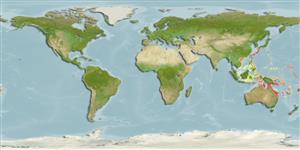Environment: milieu / climate zone / depth range / distribution range
Ökologie
seewasser riff-verbunden; tiefenbereich 1 - 20 m (Ref. 9710), usually 10 - 20 m (Ref. 9710). Tropical
Western Central Pacific: endemic to Queensland, Australia.
Size / Gewicht / Alter
Maturity: Lm ? range ? - ? cm
Max length : 15.0 cm TL Männchen/unbestimmt; (Ref. 9710)
Rückenflossenstacheln (insgesamt) : 3; Rückenflossenweichstrahlen (insgesamt) : 32 - 37; Afterflossenstacheln: 3; Afterflossenweichstrahlen: 18 - 21. Color variable depending on sex; male mainly red anteriorly and purplish posteriorly; dorsal, anal and caudal fins bluish except dorsal reddish on anterior part; female with a grayish head, largely yellow-orange on side, with 5-6 brown bars on upper half of anterior part of body; fins largely reddish (Ref. 2334).
Usually found in or near holes of coral reefs (Ref. 9710). Minimum depth from https://www.reeflifesurvey.com/species/ogilbyina-queenslandiae/.
Life cycle and mating behavior
Maturities | Fortpflanzung | Spawnings | Egg(s) | Fecundities | Larven
Bi-directional sex change has been proposed for this species though histological analysis of more specimens is needed for confirmation (Ref. 103751).
Paxton, J.R., D.F. Hoese, G.R. Allen and J.E. Hanley, 1989. Pisces. Petromyzontidae to Carangidae. Zoological Catalogue of Australia, Vol. 7. Australian Government Publishing Service, Canberra, 665 p. (Ref. 7300)
IUCN Rote Liste Status (Ref. 130435)
Bedrohung für Menschen
Harmless
Nutzung durch Menschen
Fischereien: kommerziell; Aquarium: Kommerziell
Tools
Zusatzinformationen
Download XML
Internet Quellen
Estimates based on models
Preferred temperature (Ref.
123201): 24.6 - 27.9, mean 26.6 °C (based on 72 cells).
Phylogenetic diversity index (Ref.
82804): PD
50 = 0.6250 [Uniqueness, from 0.5 = low to 2.0 = high].
Bayesian length-weight: a=0.01148 (0.00439 - 0.03002), b=3.01 (2.78 - 3.24), in cm total length, based on LWR estimates for this (Sub)family-body shape (Ref.
93245).
Trophic level (Ref.
69278): 3.8 ±0.5 se; based on size and trophs of closest relatives
Widerstandsfähigkeit (Ref.
120179): hoch, Verdopplung der Population dauert weniger als 15 Monate. (Preliminary K or Fecundity.).
Fishing Vulnerability (Ref.
59153): Low vulnerability (10 of 100).
Nutrients (Ref.
124155): Calcium = 87 [53, 142] mg/100g; Iron = 0.697 [0.447, 1.099] mg/100g; Protein = 19.1 [18.1, 20.0] %; Omega3 = 0.152 [0.100, 0.226] g/100g; Selenium = 21.1 [12.6, 36.7] μg/100g; VitaminA = 137 [52, 358] μg/100g; Zinc = 1.57 [1.12, 2.13] mg/100g (wet weight);
